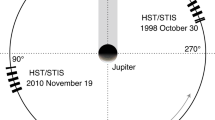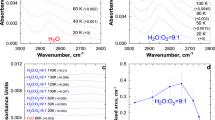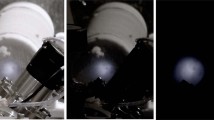Abstract
The signature of condensed molecular oxygen has been reported in recent optical-reflectance measurements of the jovian moon Ganymede1, and a tenuous oxygen atmosphere has been observed on Europa2. The surfaces of these moons contain large amounts of water ice, and it is thought that O2 is formed by the sputtering ofice by energetic particles from the jovian magnetosphere3,4,5,6,7,8. Understanding how O2 might be formed from low-temperature ice is crucial for theoretical and experimental simulations of the surfaces and atmospheres of icy bodies in the Solar System. Here we report laboratory measurements of the threshold energy, cross-section and temperature dependence of O2 production by electronic excitation of ice in vacuum, following electron-beam irradiation. Molecular oxygen is formed by direct excitation and dissociation of a stable precursor molecule, rather than (as has been previously thought) by diffusion and chemical recombination of precursor fragments. The large cross-section for O2 production suggests that electronic excitation plays an important part in the formation of O2 on Ganymede and Europa.
This is a preview of subscription content, access via your institution
Access options
Subscribe to this journal
Receive 51 print issues and online access
$199.00 per year
only $3.90 per issue
Buy this article
- Purchase on Springer Link
- Instant access to full article PDF
Prices may be subject to local taxes which are calculated during checkout


Similar content being viewed by others
References
Spencer, J. R., Calvin, W. M. & Person, M. J. Charge-coupled device spectra of the Galilean satellites: Molecular oxygen on Ganymede. J. Geophys. Res. 100, 19049–19056 (1995).
Hall, D. T., Strobel, D. F., Feldman, P. D., McGrath, M. A. & Weaver, H. A. Detection of an oxygen atmosphere on Jupiter's moon Europa. Nature 373, 677–679 (1995).
Calvin, W. M., Johnson, R. E. & Spencer, J. R. O2on Ganymede: Spectral characteristics and plasma formation mechanisms. Geophys. Res. Lett. 23, 673–676 (1996).
Calvin, W. M. & Spencer, J. R. Latitudinal distribution of O2on Ganymede: Observations with the Hubble Space Telescope. Icarus 130, 505–516 (1997).
Johnson, R. E. Sputtering of ices in the outer solar system. Rev. Mod. Phys. 68, 305–312 (1996).
Johnson, R. E. & Quickenden, T. I. Photolysis and radiolysis of water ice on outer solar system bodies. J. Geophys. Res. 102, 10985–10996 (1997).
Vidal, R. A., Bahr, D., Baragiola, R. A. & Peters, M. Oxygen on Ganymede: Laboratory studies. Science 276, 1839–1842 (1997).
Ip, W.-H., Williams, D. J., McEntire, R. W. & Mauk, B. Energetic ion sputtering effects at Ganymede. Geophys. Res. Lett. 24, 2631–2634 ((1997).
Lanzerotti, L. J., Brown, W. L., Poate, J. M. & Augustyniak, W. M. On the contribution of water products from Galiliean satellites to the Jovian magnetosphere. Geophys. Res. Lett. 5, 155–158 (1978).
Johnson, R. E. Energetic Charged-particle Interactions with Atmospheres and Surfaces (Springer, Berlin, (1990).
Johnson, R. E., Lanzerotti, L. J., Brown, W. L. & Armstrong, T. P. Erosion of Galilean satellite surfaces by Jovian magnetosphere particles. Science 212, 1027–1030 (1980).
Brown, W. L., Lanzerotti, L. J., Poate, J. M. & Augustyniak, W. M. “Sputtering” of ice by MeV light ions. Phys. Rev. Lett. 40, 1027–1030 (1978).
Kimmel, G. A. & Orlando, T. M. Low-energy (5-120 eV) electron-stimulated dissociation of amorphous D2O ice: D(2S), O(3P2,1,0) and O(1D2) yields and velocity distributions. Phys. Rev. Lett. 75, 2606–2609 (1995).
Sieger, M. T., Simpson, W. C. & Orlando, T. M. Electron-stimulated desorption of D+ from D2O ice: Surface structure and electronic excitations. Phys. Rev. B 56, 4925–4937 (1997).
Brown et al. Erosion and molecule formation in condensed gas films by electronic energy loss of fast ions. Nucl. Inst. Methods 198 1–8 ((1982).
Reimann, C. T. et al. Ion-induced molecular ejection from D2O ice. Surf. Sci. 147, 227–240 (1984).
Westley, M. S., Baragiola, R. A., Johnson, R. E. & Baratta, G. A. Photodesorption from low-temperature water ice in interstellar and circumsolar grains. Nature 373, 405–407 (1995).
Simpson, W. C. et al. Dissociative electron attachment in nanoscale ice films: Temperature and morphology effects. J. Chem. Phys. 107, 8668–8678 (1997).
Bednarek, J., Plonka, A., Hallbrucker, A., Mayer, E. & Symons, M. C. R. Hydroperoxyl radical generation by gamma-irradiation of glassy water at 77 K. J. Am. Chem. Soc. 118, 9387–9390 (1996).
Taub, I. A. & Eiben, K. Transient solvated electron, hydroxyl, and hydroperoxy radicals in pulse-irradiated crystalline ice. J. Chem. Phys. 49, 2499–2513 (1968).
Noll, K. S., Johnson, R. E., McGrath, M. A. & Caldwell, J. J. Detection of SO2on Callisto with the Hubble Space Telescope. Geophys. Res. Lett. 24, 1139–1142 (1997).
Noll, K. S., Johnson, R. E., Lane, A. L., Domingue, D. L. & Weaver, H. A. Detection of ozone on Ganymede. Science 273, 341–343 (1996).
Lacombe, S. et al. Electron-induced synthesis of ozone in a dioxygen matrix. Phys. Rev. Lett. 79, 1146–1149 (1997).
Acknowledgements
We thank G. A. Kimmel for discussions. This work was supported by the US Department of Energy, Office of Basic Energy Sciences, Chemical Physics Program. Pacific Northwest National Laboratory is operated for the US Department of Energy by Battelle Memorial Institute.
Author information
Authors and Affiliations
Corresponding author
Rights and permissions
About this article
Cite this article
Sieger, M., Simpson, W. & Orlando, T. Production of O2 on icy satellites by electronic excitation of low-temperature water ice. Nature 394, 554–556 (1998). https://doi.org/10.1038/29015
Received:
Accepted:
Issue Date:
DOI: https://doi.org/10.1038/29015
This article is cited by
-
Origin of Molecular Oxygen in Comets: Current Knowledge and Perspectives
Space Science Reviews (2018)
Comments
By submitting a comment you agree to abide by our Terms and Community Guidelines. If you find something abusive or that does not comply with our terms or guidelines please flag it as inappropriate.



